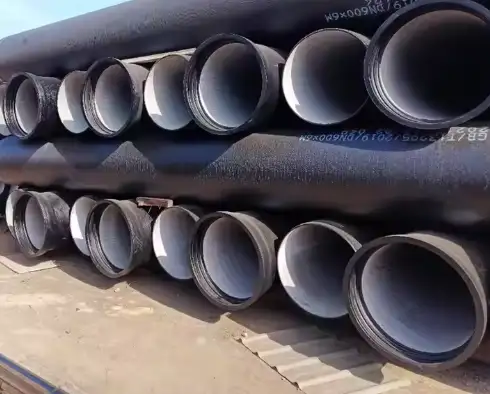The question “Is carbon steel ductile iron pipe?” arises due to the similarities in appearance between carbon steel and ductile iron pipes. However, these two materials are distinct in composition, properties, and applications. Understanding their differences is crucial for selecting the appropriate material for specific piping needs.

What Is Carbon Steel?
Carbon steel is a type of steel where the main interstitial alloying constituent is carbon. The carbon content can vary, typically up to 2.1% by weight, depending on the grade. This composition imparts strength and hardness to the material.
Properties of Carbon Steel
-
Strength and Hardness: Higher carbon content increases hardness and tensile strength but reduces ductility.
-
Weldability: Welding carbon steel is generally straightforward, though higher carbon content can make it more susceptible to cracking.
-
Corrosion Resistance: Carbon steel is prone to rusting when exposed to moisture and air, requiring protective coatings or galvanization.
-
Cost: Generally more cost-effective compared to other materials like stainless steel.
What Is Ductile Iron?
Ductile iron, also known as nodular cast iron, is a type of cast iron that has been treated with small amounts of magnesium to promote the formation of spherical graphite nodules. This modification imparts improved ductility, tensile strength, and impact resistance compared to traditional gray cast iron.
Properties of Ductile Iron
-
Ductility: Enhanced ductility allows for greater deformation before fracture.
-
Strength: Offers high tensile strength, making it suitable for high-pressure applications.
-
Corrosion Resistance: Superior to carbon steel, especially when coated or lined.
-
Machinability: Good machinability, though not as high as that of carbon steel.
-
Cost: Generally more expensive than carbon steel due to the alloying process.
Comparison of Carbon Steel and Ductile Iron Pipes
| Property | Carbon Steel Pipe | Ductile Iron Pipe |
|---|---|---|
| Composition | Primarily iron with carbon content | Iron alloyed with magnesium |
| Strength | High tensile strength | High tensile strength |
| Ductility | Lower due to higher carbon content | Higher due to spherical graphite structure |
| Corrosion Resistance | Prone to rust without coating | Superior, especially with internal linings |
| Weldability | Generally good | Challenging; requires preheating and post-weld heat treatment |
| Cost | Generally lower | Generally higher |
| Applications | Structural applications, pipelines | Water and wastewater systems, fire protection systems |
Applications of Carbon Steel and Ductile Iron Pipes
Carbon Steel Pipes
-
Structural Applications: Used in construction for structural supports and frameworks.
-
Oil and Gas Pipelines: Suitable for transporting oil and gas due to its strength.
-
Industrial Applications: Utilized in machinery and equipment manufacturing.
Ductile Iron Pipes
-
Water Distribution Systems: Preferred for potable water supply due to corrosion resistance.
-
Wastewater Systems: Used for sewage and wastewater transport.
-
Fire Protection Systems: Employed in fire hydrant and sprinkler systems.
Advantages and Limitations
Carbon Steel Pipes
Advantages:
-
Strength: High tensile strength suitable for heavy-duty applications.
-
Weldability: Easier to weld compared to ductile iron.
-
Cost: More affordable, making it cost-effective for various applications.
Limitations:
-
Corrosion Resistance: Susceptible to rusting without protective coatings.
-
Ductility: Lower ductility can lead to brittle fractures under stress.
Ductile Iron Pipes
Advantages:
-
Corrosion Resistance: Superior resistance to corrosion, especially when lined.
-
Ductility: Higher ductility allows for better deformation without failure.
-
Strength: High tensile strength suitable for high-pressure applications.
Limitations:
-
Weldability: More challenging to weld; requires specialized techniques.
-
Cost: Generally more expensive than carbon steel.
Frequently Asked Questions (FAQs)
1. Can ductile iron pipes be welded?
Welding ductile iron pipes is possible but requires specialized procedures. The presence of graphite nodules can cause cracking during welding, necessitating preheating and post-weld heat treatment to reduce stress and prevent failure. Alternatively, mechanical joints or flanged connections are often used to join ductile iron pipes.
2. What are the benefits of using ductile iron pipes over carbon steel?
Ductile iron pipes offer superior corrosion resistance, making them ideal for water and wastewater systems. Their higher ductility allows them to withstand ground movements and pressure surges better than carbon steel pipes. Additionally, ductile iron pipes often have a longer service life, reducing maintenance costs over time.
3. Are ductile iron pipes more expensive than carbon steel pipes?
Yes, ductile iron pipes are generally more expensive than carbon steel pipes. The manufacturing process involves alloying with magnesium, which adds to the cost. However, the increased durability and reduced maintenance costs can offset the initial investment over the pipe’s lifespan.
4. Can carbon steel pipes be used for water distribution?
While carbon steel pipes can be used for water distribution, they are more susceptible to corrosion compared to ductile iron pipes. Without protective coatings or galvanization, carbon steel pipes can rust over time, compromising water quality and system integrity.
5. What is the typical lifespan of ductile iron pipes?
Ductile iron pipes can have a service life of 50 to 100 years, depending on environmental conditions and maintenance practices. Their resistance to corrosion and ability to withstand pressure surges contribute to their longevity.
6. Can ductile iron pipes be used in seismic zones?
Yes, ductile iron pipes are suitable for use in seismic zones due to their flexibility and ability to absorb shock. Their ductility allows them to bend without breaking, making them resilient to ground movements during earthquakes.
Conclusion
While carbon steel and ductile iron pipes may appear similar, they possess distinct properties that make them suitable for different applications. Carbon steel pipes are valued for their strength and weldability, making them ideal for structural and industrial applications. In contrast, ductile iron pipes offer superior corrosion resistance and ductility, making them the preferred choice for water and wastewater systems. Understanding the differences between these materials ensures the selection of the appropriate pipe for specific needs, balancing factors like cost, durability, and application requirements.
